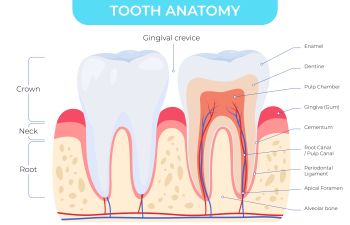
A tooth is made up of layers. This is not a metaphor. There are three layers that are most important to the structure of a tooth: the topmost enamel layer, the underlying dentin layer, and the pulp chamber which is full of a soft tissue known as dental pulp. When the structures of a tooth is adversely effected, a dentist at our Missouri City, TX practice can help.
Let’s consider each of these layers individually below. We’ll then note some restorative dentistry procedures to address problems that impact your tooth structure, as offer some common sense tips for good oral hygiene and preventative dental care.
The Enamel Layer
The surface layer of a tooth is comprised of enamel, which is one of the hardest substances in the human body. The enamel is highly durable, and able to withstand major wear and tear a person would normally sustain from biting and chewing.
Cavities occur when the acidity produced by oral bacteria eats through part of the enamel. This can damage lower layers of tooth structure, resulting in more extensive and severe degrees of decay.
The Dentin Layer
Beneath the tooth enamel is the dentin layer of a tooth. Dentin is a porous substance. While durable, it is not as strong as the tooth enamel. The little pores in the dentin are called dentinal tubules, and they help the tooth register sensations of pressure and temperature.
If the dentin is affected by tooth decay, it can spread faster than it would with tooth enamel. The dentinal tubules also mean a risk of oral bacteria reaching in pulp chamber of the tooth.
Dental Pulp and the Pulp Chamber
Inside of every tooth is a bit of tissue called dental pulp. This dental pulp is comprised of nerves, blood vessels, and connective tissue that were essential for the initial formation of the tooth.
When oral bacteria reaches the dental pulp, the result if a painful problem known as a root canal infection. Left untreated, a root canal infection can lead to severe pain and the spread of infection to other parts of the mouth.
Repairing Tooth Decay
Tooth decay can be treated by rebuilding the compromised or missing tooth structure with a restoration. This may mean a dental filling, inlay, onlay, or crown. Your dentist can determine the ideal restoration to repair the damage done to your teeth.
Addressing Root Canal Infections
When a root canal infection has occurred, enodontic therapy (a root canal) is recommended. This removes the infected dental pulp and fills the pulp chamber with an inert and sterile material. If the tooth cannot be saved, the best option for treatment is to extract the tooth.
Tips for Keeping Your Teeth Healthy
The best way to preserve the health of your smile and reduce your risk of serious dental problems is to follow these simple tips:
- Brush your teeth at least twice a day (ideally after every meal)
- Floss your teeth at least once a night (ideally after every meal)
- Reduce your consumption of soda and sugar
- Avoid using tobacco products
- Wear mouth or face protection whenever applicable
- Visit your dentist for regular checkups
Learn More About Dental Care
For more information about your dental health needs, we encourage you to contact Fort Bend Dental. We are here to help you experience the best dental health possible and have smiles that last for years to come.
Posted on behalf of

